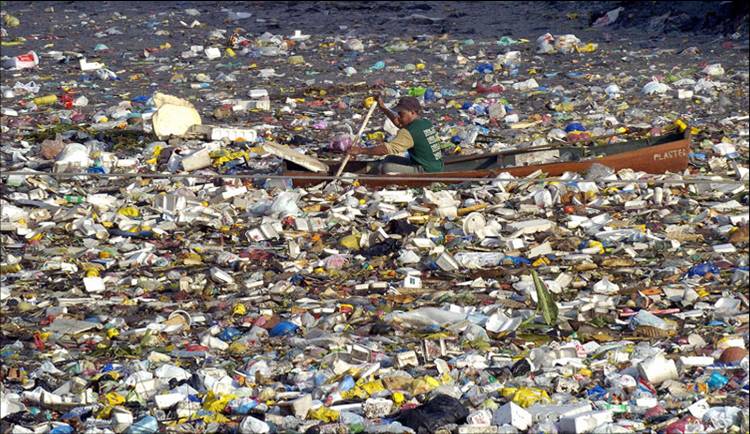|
Watch Out: We Are Getting Wasted!
A bout 800 km off the coast of California and 300 km off the coast of Japan, deep within the Pacific Ocean, is a stretch that can be one of the symbols of modern civilisation.The Great Pacific Garbage Patch, as it has been named, estimated to be more than four times the size of India, is filled with trash consisting mostly of plastic debris. This enormous amount of plastic has been discarded from the land, carried by the wind, rainwater, through the drains to the rivers and streams and finally into the ocean. The ocean current has carried them in its whim to the patch in the Pacific Ocean. In a 2001 study, researchers
found concentrations of plastic This undoubtedly sounds disturbing and disgusting. Many of us will agree to the fact that it is an alarming situation. There are countless initiatives taken all around the world, in the light of this massive garbage creation. Fantastically creative and winning ideas have been carved out to reuse, recycle, renovate and redefine waste. So much and such is the quantum of waste we have managed to create that even big businesses today are being spun out on the realm of wastes, using them as the central raw material. It is absolutely important that people across the globe do something about the waste that has been created for over generations. However, this article attempts to understand why this free-flow of wastes must exist in the first place and how we are just so unsuspectingly trashing the planet. We, human beings, as a species, are hardwired to be able to respond to issues which we perceive with our senses. Melting arctic glaciers, scarily fast endangering of species, the retreating Rajasthan desert, losing 2000 tress a minute in the Amazon rainforest; none of these things seem to bother most of us too much, since they are out of our immediate visual perception. According to a study, only 1 per cent of goods that go through the entire cycle of making them remain either in production or in use six months after their sale; which means that 99 per cent of these goods are trashed. Extraction of natural resources and raw materials, manufacturing and production of goods, disposal, services given by men and women throughout the process, land-water-air exploited for this production and disposal – are all kept out of vision of the end consumer. If we observe, frivolous consumption setting off hitherto non-existent wants or desires is largely sparked by the advertising/ media/ marketing trio. Another thing about advertisements is that it implants a sense of lack of adequacy in the mind of consumers. The only proposed solution then to get rid of this feeling of inferiority is ‘shopping’. Every day, an average Indian is targeted by over 3000 advertisements. People today see more advertisements in a year than people 50 years back saw in a lifetime. Also, there is pressure upon the subconscious desires of people to keep up with the Joneses and maintain the right quantity and quality of status goods within their social circle. But, say, one person within this group purchases a superior quality of commodity than those possessed by the others in the group. The value of this commodity within this group immediately falls down. The effect of a costlier symbol lowers the value of the preceding status acquisition within that group. Here, psychology drives consumption and not utility, but plainly the factor of possession by others in the group. The society is constantly exposed to the danger of conspicuous consumption and becomes competitive, simply increasing consumption and waste generation exponentially. Let’s look at homes. Our home makes a good part of our ecological footprint. First, let us keep aside the question of how much space does a human being actually need to survive. In this age of competitive consumption, the answers are mercilessly choice-driven and subjective. Antilia (The twenty-seven floor personal home for six family members with 600 full-time staff, belonging to businessman Mukesh Ambani and also the most expensive home in the world) is obviously an extreme example. However, average families in towns and cities too are caught in the quest for bigger and better homes. A bigger home, with more space, calls for bigger investments into filling it with stuff and equipping it with more energy consumptive systems or, as we understand it today, making it more comfortable. Here, the wastages created are not only in commodities but in energy as well. The extra amount of energy in building the space, heating/cooling it, lighting it, maintaining it, can be understood as energy waste, since it is unnecessary. To understand from a living example, Development Alternatives has set a significant example by building their headquarters as one of the first buildings in India that aims at zero emissions. Its construction has involved a wide range of resource-saving strategies, ranging from the use of eco-materials to rainwater harvesting and natural lighting. The desire of individuals to consume more and more, propelled by marketing, media and industry often feeds into the desires of policy makers to have an ever expanding economy. In this era of competitive electoral polity, every government seems more sincere than the previous one in an attempt to try and increase the consumption of the population. While this might be a noble intention to alleviate struggle for a section of population, it hampers the environment in an increasing number of ways. ‘Blame Game’ could be an endless indulgence with the meagre assurance of identifying and/or then validating the culprits but the stakeholder is surely the whole world. ‘How much do we really need?’ isn’t a question to be asked but should be answered by each one of us. q Karnika Palwa
References :http://www.telegraph.co.uk/earth/environment/5208645/Drowning-in-plastic-The-Great-Pacific-Garbage-Patch-is-twice-the-size-of-France.html http://www.storyofstuff.com/ http://en.wikipedia.org/wiki/Great_Pacific_Garbage_Patch
|
 particles at 334,721 pieces per km
particles at 334,721 pieces per km